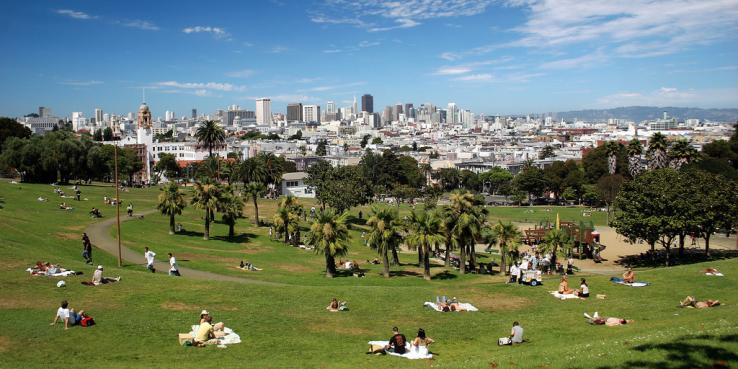Value of San Francisco’s parks: priceless? Actually, it’s about $1 billion per year, according to a new report from the Trust for Public Land and the SF Parks Alliance.
Most urban park users don’t calculate the benefits of open space and recreation opportunities in dollars. But in public policy decisions — like how to allocate funding between city departments — a cost-benefit analysis is often critical to advancing one priority over another. In these discussions, parks have historically come up short on the ability to demonstrate their economic value. While the aesthetic and health benefits of parks and open space in urban areas are obvious, the contributions of parks to economic development, household wealth and municipal cost savings have been less recognized.
Since 2003, a series of reports from the national Trust For Public Land (TPL) has attempted to quantify the value of urban park and recreation systems in 12 cities around the country, using a series of measures including contributions to property values, tourism, health, community, clean water and clean air.
The latest report, commissioned by the SF Parks Alliance and written by Peter Harnik, examines the economic benefits of San Francisco’s park and recreation system. The report's conservative estimate is that San Francisco’s parks supply $959 million in value per year to the city.
This value comes from a number of sources:
- Property values: $147 million. Proximity to parks in a dense urban area like San Francisco increases property values, resulting in greater wealth for the property owners and increased tax receipts for the city. ($147 million is the total of $123 million in additional property sales value from park proximity and $24 million in increased tax receipts to the city.)
- Tourism value: $47 million. The report estimated that approximately 15 percent of San Francisco’s tourism economy is driven by the attractiveness of San Francisco’s parks. This makes sense if you consider the stops in most guidebooks: Golden Gate Park, Alamo Square, Coit Tower, museums, marinas and stadiums, to name just a few. Tax receipts from the increased tourism attributable to San Francisco’s parks enrich the city.
- Direct use value: $212 million. San Franciscans derive valuable recreational services from their public parks for free. From golfing to the use of fields, courts and dog runs, each activity is assigned a value based on what users would be willing to pay for it on the private market if the public option were not available.
- Health value: $49 million. The health value of parks estimates the savings in medical costs for residents who are physically active in San Francisco’s parks.
- Community cohesion value: $67 million. The social capital of parks is one of the most difficult measures to quantify. TLP arrives at a proxy by adding up volunteer hours and philanthropic contributions to parks.
- Stormwater retention and air pollution removal value: $1.9 million and $3.1 million. Urban parks absorb stormwater runoff and remove pollution from the air. The city saves on runoff treatment costs and sees value from the tons of pollution removed from the air, averting damage to health and structures.
Parks clearly deliver a tremendous financial benefit to the city – both to the municipal entity that provides public services and to its individual residents, workers and visitors. And this report presents a conservative estimate of these benefits. For example, the calculation of parks’ effects on property value excludes parks smaller than one acre, properties more than 500 feet from a park and all commercial property. Overall, the economic benefits of San Francisco parks are likely much greater than this initial estimate posits.
The report treats all park and recreational spaces in San Francisco as relatively equal in the benefits they generate, though this certainly isn’t the case on the ground. Coit Tower is responsible for attracting more tourism dollars than Grand View Park. Glen Park probably contributes in a greater way to stormwater and air quality benefits than do the playing courts at Crocker Amazon.
Do San Franciscans need more parks? This report may seem to suggest that there are benefits to expanding park land, but it also demonstrates how residents could be getting more value from underutilized parks — and it underscores the importance of maintaining the parks we have.
San Francisco’s General Fund contributions to parks shrank dramatically in the last recession, and public natural assets like street trees are being shifted out of the system for lack of resources to maintain them. Putting a number on how parks generate revenue for the city could aid parks advocates and city leaders in making the case for continued investment in some of San Francisco's most treasured assets.
Read SPUR’s recommendations on funding San Francisco parks >>
